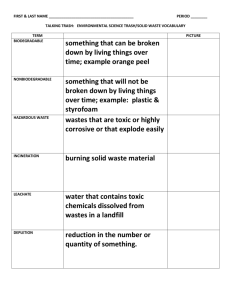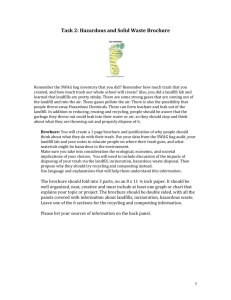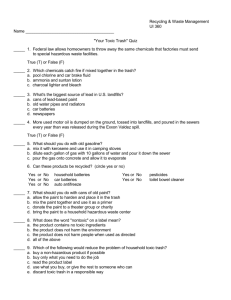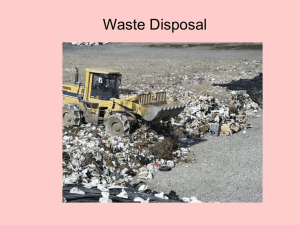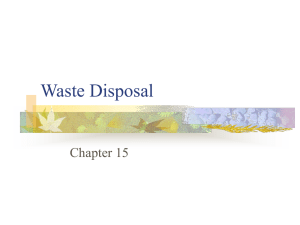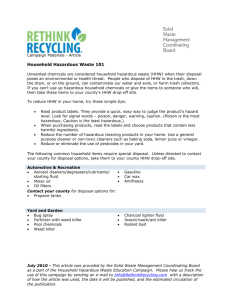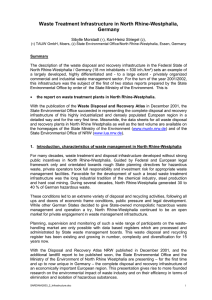History of Waste Management p.653
advertisement
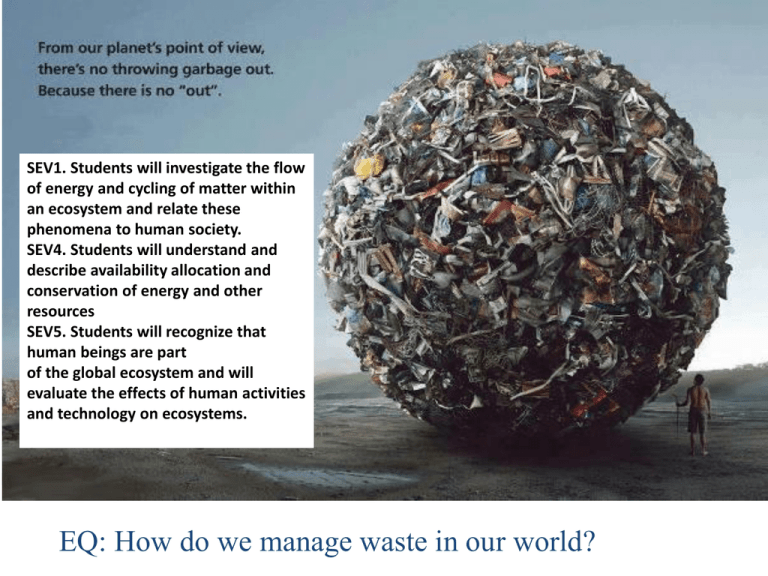
SEV1. Students will investigate the flow of energy and cycling of matter within an ecosystem and relate these phenomena to human society. SEV4. Students will understand and describe availability allocation and conservation of energy and other resources SEV5. Students will recognize that human beings are part of the global ecosystem and will evaluate the effects of human activities and technology on ecosystems. EQ: How do we manage waste in our world? History of Waste Management p.653 Today we understand more about ecology, the water cycle, by –products, and we know the atmosphere and Oceans have a limited capacity to absorb wastes and recycle materials naturally The Volume of Waste has doubled since 1960! Why? ??? Population Growth, Increase in Disposable Materials, Excessive packaging, etc. We are a Throw Away Society! USA produces > 11 billion tons of solid waste each year I. Municipal Solid Waste (MSW) Garbage or Trash Create a list of MSW from most to least II. Hazardous Waste Highly flammable, Corrosive, Toxic (poisonous, carcinogenic, related to birth defects), Infectious, Radioactive Household Hazardous Waste (HHW) Oil-based paints Fluorescent light bulbs Nail Polish Engine oil Electronic wastes *linked to intellectual disabilities (lead), cancer, birth defects, sterility, other psychological & neurological problems, & endocrine disruption HHW Disposal Options/ Chart • Federal law allows disposal of HHW in the trash. • EPA encourages using collection programs! • Reading labels for disposal directions reduces the risk of products posing hazards on the way to a disposal facility. • Even empty containers of HHW can pose hazards because of the residual chemicals that might remain. • Potential to cause physical injury to sanitation workers, contaminate septic tanks or wastewater treatment systems if poured down drains or toilets! http://www.mrwpca.org/dwnloads/hhw.pdf http://www.dec.ny.gov/docs/materials_minerals_pdf/hhwcht.pdf http://www.columbusga.org/engineering2/household_hazardous_waste.pdf Safer alternatives http://www.sierraclub.ca/national/programs/health-environment/pesticides/alternative-household-prod.pdf Product Wrap & discard w/trash toilet bowl cleaner oven cleaner Take to a Hazardous waste collection site Take to a Recycling Center Dry out then put in trash X General purpose cleaner scouring cleaner Pour in drain w/plenty of water Alternatives Vinegar & water X Baking soda or borax X Baking soda or borax X Baking soda X latex paint milk paint oil-based paint X use latex paint thinner X let paint settle out & reuse X motor oil gasoline X household batteries X vehicle batteries ----------------- X rechargeable X ---------- bug spray/insecticide X keep householdclean/seal entryways mothballs X cedar, keep garments sealed in boxes Pharmaceuticals (antibiotics, hormone replacement drugs, & bipolar disorder drugs, etc. ) have been detected in bodies of water & drinking water III. Disposal (list the disposal methods greatest to least) Interstate transfer… N.Y. Staten Island closed its Fresh kill landfill and pays $64/ton to ship to other states. It produces 11,000 tons / day! Bad Ideas http://www.youtube.com/watch?v=2VrrxMIiwgQ Streams were sewers: 1960’s Cuyahoga River, Cleveland, OH carried so much flammable material it caught fire & destroyed 7 bridges before it burnt itself out Great Pacific Garbage Patch & Packaging Your Product Activity Open Dumps –results in exposure to refuse & air pollution https://www.youtube.com/watch?v=mEIo65krAAI Exporting Waste - ex. 1. toxic incineration ash from Philadelphia to Haiti, going to China, India, and Nigeria, where poor people – including children -- disassemble them to remove chips & metals for profit, w/out protective clothing, techniques include acid stripping and burning 2. e-waste /watch?v=hvx-W-XAie0 Vessel containing toxic ash sailed 16 months, before finally returning to PA, left 4,ooo tons of ash in Haiti calling it “fertilizer”, remaining 10,000 tons were dumped into the sea Better Ideas Sanitary landfillsground is lined, waste is covered (capped), leachate & methane are captured https://www.youtube.com/watch?v=mEIo65krAAI However… Leachate- potential to contaminate water supply Methane gas- potential to explode Incomplete decomposition- ex. plastics NIMBY- not in my backyard attitude Detroit & Riverview Michigan mine landfill gas under a 212 acre landfill called Mt. Trashmore In Florida 150 former landfill sites are on the Superfund list b/c they are in wetlands. Superfund is a federal program with the responsibility of cleaning up sites that are in danger of jeopardizing human health through ground water contamination. active Danehy Park Cambridge, MA was once an open burning dump then it was turned into a sanitary landfill, until it was closed in 1952, today it is a 55 acre park with soccer fields, basketball courts, and baseball diamonds. Incineration – Reduces weight of trash, can produce fuel, creates air pollution & toxic ash (i.e. particulate matter, lead, mercury, dioxins, furans, puts workers at risk) a group of chemicals that are formed during combustion processes such as waste incineration, power generation, metal production and fuel burning Phytoremediation: Sunflowers: radioactive materials (Strontium-90, Cesium-137) Poplars, willows: dry cleaning solvents & uranium Indian mustard, brake ferns: lead and arsenic IV. Sustainability: A. Reduce Establish cradle-to-grave responsibility laws: require companies to take back products (electronics & appliances) at end of life to be repaired or recycle • • • • • 2 liter soft drink bottle 35% lighter Steel cans are 60% lighter Disposable diapers contain 50% less pulp Information Age is reducing paper use Resale, yard sale, flea markets, consignment on the rise • Recycling Success Stories- plastic to outdoor apparel, tires to asphalt, paper to cardboard or more paper B. Copy any three C. Recycle the process of collecting and processing materials that would otherwise be thrown away as trash and turning them into new products Benefits Reduces the amount of waste sent to landfills and incinerators Conserves natural resources such as timber, water, and minerals Saves energy Helps create U.S. jobs in recycling and manufacturing Continuous loop Step 1: Collection and Processing Step 2: Manufacturing Step 3: Purchasing New Products Made from Recycled Materials prevented 86.9 million tons of material away & prevented the release of ≈183 million metric tons of carbon dioxide into the air (2011) equivalent to taking 34 million cars off the road for a year. http://www.epa.gov/epawaste/nonhaz/municipal/index.htm D. BIOPLASTICS- BIODEGRADABLE Made from plants (corn, soybean) E. COMPOSTING- Reduces chemical fertilizers & MSW V. Waste Regulations A. Resource Conservation and Recovery Act (RCRA) • Set standards for management of dumps/landfills, cradle to grave laws B. Comprehensive Environmental Response, Compensation, and Liability Act (CERCLA; Superfund Act) • Identifies hazardous waste sites & clean them • Who Pays? Tax on oil & chemical companies that funded the Superfund Act expired in 1995, not renewed; now taxpayers clean up superfund sites Armstrong World Industries in Macon is now a federal Superfund site. Flathead Catfish in the nearby Ocmulgee River have been found to contain cancercausing chemicals. (photo courtesy USFWS, 2011) Ground water extraction system at the Monsanto Corp. (Augusta Plant) site. Ground water tested positive for arsenic. VI. Environmental Justice • Idea that no group of people should bear a disproportionate share of negative environmental consequences • • 870,000 U.S. federal subsidized housing units are within a mile of factories that report toxic emissions to the EPA Emelle, AL largest hazardous waste landfill and 90% of the town is African American https://www.youtube.com/watch?v=zJX_MXaXbJA https://www.youtube.com/watch?v=5-GkLV-f7-0 http://www.pbslearningmedia.org/resource/envh10.sci.life.eco.envracism/environmental-justice-opposing-a-toxic-waste-landfill/ http://www.pbslearningmedia.org/resource/envh10.sci.life.eco.enhdiscrim/environmental-justice-opposing-a-toxic-waste-incinerator/
